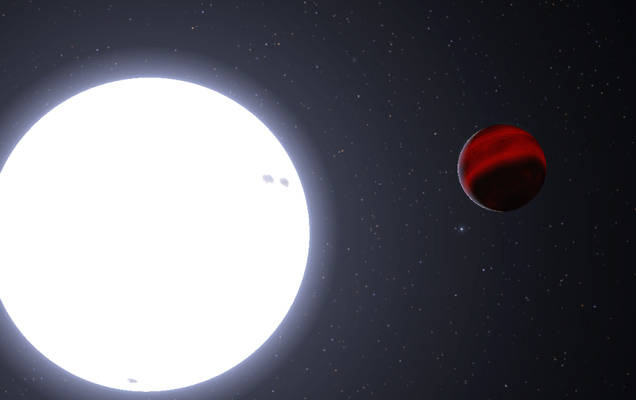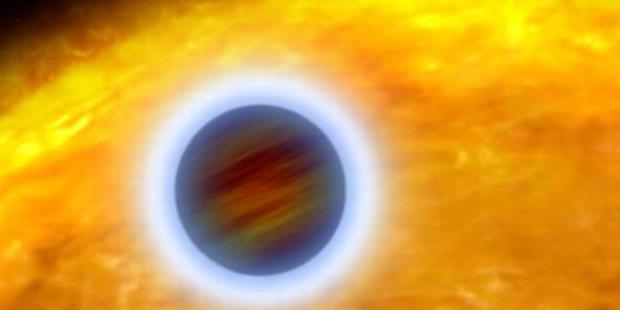WASP-33b, Hottest Planet's
More Heat From Multiple
Stars


Astronomers involved in the
project Super Wide Angle
Search for Planets (SuperWASP)
have discovered the hottest
planet called WASP-33b. The
temperature of the planet is
hotter than the temperature
of some stars.
The existence of the planet has
been suspected since 2006, but
was only confirmed in 2010
yesterday. Known, the planet is
classified in this type of gas
planets with masses less than
4.5 times the mass of Jupiter.
Based on observations with the
William Herschel Telescope,
WASP-33b temperatures
reaching 3200 degrees Celsius.
The temperature was hotter
than a red dwarf star with a
temperature 700 degrees
Celsius and WASP-12b where
the temperature in 2300
degrees Celsius.
One cause of the heat of the
planet's temperature is the
temperature of the parent
star is too hot. Astronomers
said the temperature of the
planet's parent star is 7160
degrees Celsius, higher than
the temperature of the sun is
only 5600 degrees Celsius.
Meanwhile, another reason is
the proximity distance of
WASP-33b orbits the parent
star.
With a distance of only 7
percent of the distance
Mercury-Sun, the planet
seemed to be "contaminated"
hot parent star.
The study of the planet led by
Alexis Smith of the University of
Keele in Stafordshire, England.
Through this study, the
astronomers also know that
the planet's revolution time is
very short, only 29.5 hours.
Drake Demming of NASA's
Goddard Space Flight Center in
Greenbelt, Maryland who was
not involved in the study, said,
"WASP-33b could help
astronomers examine the hot
planetary the characteristic still
a mystery."
Lesson to be learned for
example the orbit planet close
to its star that has a layer of
the atmosphere is cooler
outside than inside layer. This is
surprising because the planet is
"heated" from the outside.
Deming said that fact could be
related to the presence of
carbon-based compounds that
change the way the
atmosphere respond to
radiation. Certain chemical
compounds can be formed by
ultraviolet light from the star.
"It certainly would be a planet
you want to see. This is a very
rare opportunity to study the
planet orbiting the star is
super hot," said Deming in his
interview with New Scientist.
More Heat From Multiple
Stars


Astronomers involved in the
project Super Wide Angle
Search for Planets (SuperWASP)
have discovered the hottest
planet called WASP-33b. The
temperature of the planet is
hotter than the temperature
of some stars.
The existence of the planet has
been suspected since 2006, but
was only confirmed in 2010
yesterday. Known, the planet is
classified in this type of gas
planets with masses less than
4.5 times the mass of Jupiter.
Based on observations with the
William Herschel Telescope,
WASP-33b temperatures
reaching 3200 degrees Celsius.
The temperature was hotter
than a red dwarf star with a
temperature 700 degrees
Celsius and WASP-12b where
the temperature in 2300
degrees Celsius.
One cause of the heat of the
planet's temperature is the
temperature of the parent
star is too hot. Astronomers
said the temperature of the
planet's parent star is 7160
degrees Celsius, higher than
the temperature of the sun is
only 5600 degrees Celsius.
Meanwhile, another reason is
the proximity distance of
WASP-33b orbits the parent
star.
With a distance of only 7
percent of the distance
Mercury-Sun, the planet
seemed to be "contaminated"
hot parent star.
The study of the planet led by
Alexis Smith of the University of
Keele in Stafordshire, England.
Through this study, the
astronomers also know that
the planet's revolution time is
very short, only 29.5 hours.
Drake Demming of NASA's
Goddard Space Flight Center in
Greenbelt, Maryland who was
not involved in the study, said,
"WASP-33b could help
astronomers examine the hot
planetary the characteristic still
a mystery."
Lesson to be learned for
example the orbit planet close
to its star that has a layer of
the atmosphere is cooler
outside than inside layer. This is
surprising because the planet is
"heated" from the outside.
Deming said that fact could be
related to the presence of
carbon-based compounds that
change the way the
atmosphere respond to
radiation. Certain chemical
compounds can be formed by
ultraviolet light from the star.
"It certainly would be a planet
you want to see. This is a very
rare opportunity to study the
planet orbiting the star is
super hot," said Deming in his
interview with New Scientist.





0 comments:
Post a Comment